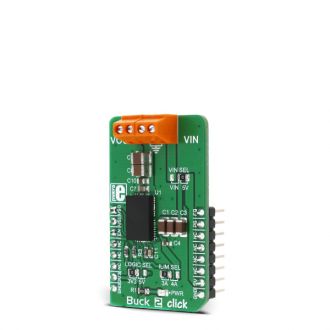
We strongly encourage users to use Package manager for sharing their code on Libstock website, because it boosts your efficiency and leaves the end user with no room for error. [more info]

Rating:
Author: MIKROE
Last Updated: 2018-02-07
Package Version: 1.0.0.0
mikroSDK Library: 1.0.0.0
Category: Buck
Downloaded: 5943 times
Not followed.
License: MIT license
Buck 2 click is a powerful step down DC-DC switching regulator. It gives a high precision regulated voltage at its output and it can handle an ample amount of current.
Do you want to subscribe in order to receive notifications regarding "Buck 2 click" changes.
Do you want to unsubscribe in order to stop receiving notifications regarding "Buck 2 click" changes.
Do you want to report abuse regarding "Buck 2 click".


Library Description
This library carries all necessary functions for controlling Buck 2 click.
Key functions
void buck2_setMode(uint8_t mode) - Sets up working mode
void buck2_setVOUT_3300mV() - Sets up output voltage to 3.3 V
void buck2_setVOUT_2500mV() - Sets up output voltage to 2.5 V
void buck2_setVOUT_1800mV() - Sets up output voltage to 1.8 V
void buck2_setVOUT_1500mV() - Sets up output voltage to 1.5 V
Examples Description
The demo application is composed of three sections:
void applicationTask()
{
PG_State = buck2_getPowerGood();
if ( PG_State != 0 )
{
mikrobus_logWrite("Power good output voltage", _LOG_LINE);
}
buck2_setVOUT_3300mV();
Delay_ms( 3000 );
buck2_setVOUT_2500mV();
Delay_ms( 3000 );
buck2_setVOUT_1800mV();
Delay_ms( 3000 );
buck2_setVOUT_1500mV();
Delay_ms( 3000 );
}
Other MikroElektronika libraries used in the example:
Additional notes and information
Depending on the development board you are using, you may need USB UART click, USB UART 2 click or RS232 click to connect to your PC, for development systems with no UART to USB interface available on the board. The terminal available in all MikroElektronika compilers, or any other terminal application of your choice, can be used to read the message.